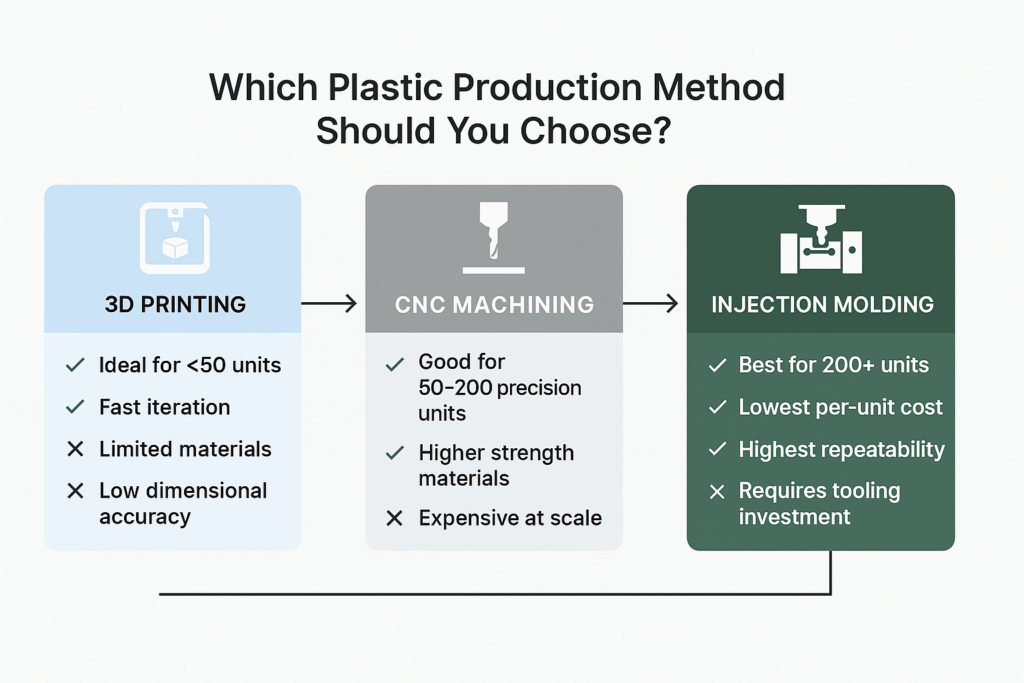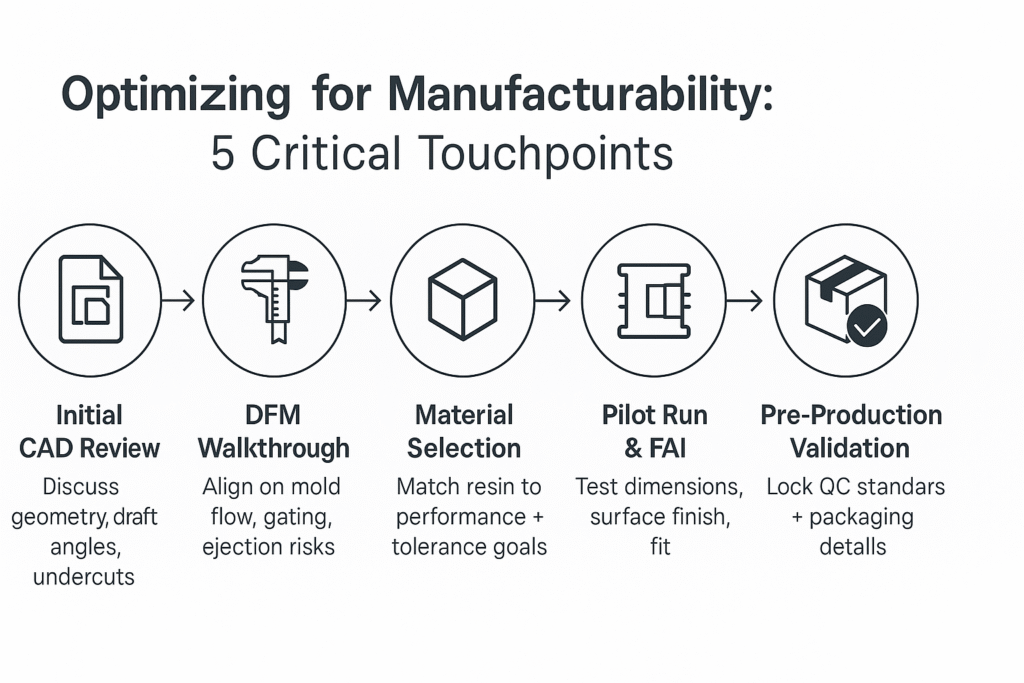
You’ve finalized your design, sourced materials, and lined up your production schedule. Then, the first batch of plastic parts arrives—and they’re warped, misaligned, or don’t assemble as intended. For product developers—whether you’re a startup founder, a project engineer, or managing a supply chain—these setbacks aren’t just frustrating; they’re expensive and potentially project-killing.
This guide offers practical strategies for bridging the critical gap between design and manufacturability, saving time, budget, and headaches.
The leap from CAD files to molded reality often uncovers unexpected flaws. A subtle curve that enhances aesthetics in a 3D model might translate into complex tooling and high defect rates once molded. Problems like inconsistent wall thickness, missing draft angles, or sharp corners are rarely caught until thousands of dollars are spent on molds.
Effective Design for Manufacturing (DFM) isn’t optional—it’s crucial. Teams that engage mold engineers early can identify and prevent costly issues, like sink marks and warping. Even seemingly minor design adjustments, such as adding a slight draft or internal ribs, can drastically reduce mold complexity and revision loops.
A common oversight occurs when product designers and mold engineers don’t communicate early enough. Designers often prioritize visual appeal and user experience, while mold engineers focus on manufacturability and tooling feasibility. Bringing these perspectives together early, through cross-functional DFM reviews, prevents expensive late-stage changes.
Selecting the appropriate manufacturing process depends on production volume, product complexity, and desired material properties. For small-scale prototypes, CNC machining or 3D printing might seem appealing due to speed and flexibility, but as quantities increase, these methods quickly become cost-prohibitive and inconsistent.
For product developers looking to optimize cost, consistency, and production speed, injection molding consistently emerges as the most reliable method for medium to large-scale output. For projects that require tight tolerances, repeatable quality, and cost efficiency at scale, plastic injection molding offers a proven, versatile solution used across industries from consumer electronics to automotive components. Unlike prototyping methods, injection molding supports a wide range of resins, provides superior surface finishes, and ensures part-to-part consistency over tens of thousands of cycles.
Case Example:
A robotics startup initially chose CNC for their prototypes, experiencing unexpected tolerance variations. Transitioning to injection molding dramatically reduced defects and improved dimensional consistency, ultimately accelerating their product launch timeline by weeks.
Quick Decision Guide:

Outsourcing manufacturing to regions like China remains attractive due to cost advantages and established infrastructure. However, selecting partners based solely on upfront cost can backfire spectacularly. A seemingly economical choice can lead to quality inconsistencies, delays, and additional expenses.
Common Pitfall:
A U.S.-based electronics company approved a subcontracted Chinese vendor’s tooling plan without verifying their internal QC processes. Resulting mold defects necessitated retooling, adding thousands in unplanned expenses and weeks in delays.
Selecting the right manufacturing partner is one of the highest-leverage moves a product developer can make to optimize plastic part production. The best suppliers act as strategic partners rather than mere vendors. They proactively identify design risks, provide transparent communication, and deliver consistent quality. Choosing such partners might cost slightly more initially but significantly reduces long-term risk and expenses. For product teams seeking a balance between affordability and reliability, working with an experienced provider in plastic manufacturing china gives access to mature tooling infrastructure, engineering support, and scalable production—all under one roof.
Each handoff in your supply chain introduces risks: miscommunication, specification misalignment, and increased latency. For product developers working with tight timelines, integrated manufacturing services—combining molding, assembly, packaging, and logistics—are a critical advantage.
Consider a scenario where different suppliers handle molding, labeling, and packaging separately. Any last-minute specification change cascades through multiple vendors, causing delays and amplifying mistakes. An integrated partner can quickly adapt, reducing downtime and potential errors.
One of the most overlooked aspects of plastic part production is the validation process. Teams often move from prototyping to full production without proper pre-production testing, resulting in avoidable errors that only emerge in field use or customer hands.
Implementing rigorous First Article Inspection (FAI), using production-grade materials in pilot runs, and performing dimensional and functional testing under real conditions can reveal critical weaknesses before scaling.
Tip: Insist on production intent samples—not just visual prototypes—before approving tooling. This ensures you’re testing exactly what you’ll be delivering.
Also, document critical-to-function features and tolerances in a shared quality checklist. When both sides agree on measurable outcomes, quality becomes predictable instead of reactive.

Even after achieving initial production success, the job isn’t done. Too many teams move on once parts meet baseline specifications—only to find recurring issues or missed optimizations months later. Building structured feedback loops into your manufacturing process ensures ongoing refinement and reliability.
Start by setting up post-production reviews after each major batch or milestone. Analyze return rates, customer complaints, and internal defect logs together with your supplier. These reviews shouldn’t just identify problems—they should drive adjustments in tooling maintenance, material selection, or operator training.
Also, consider periodic re-validation of critical dimensions, even in long-term runs. Materials age, tools wear, and environmental conditions shift. Proactive sampling and measurement prevent gradual drift from turning into systemic quality failures.
Tip: Create a shared improvement tracker between your team and your manufacturer. Each issue, once identified, should trigger a resolution plan with defined owners and deadlines. This turns passive observation into active quality ownership.
Before finalizing a partnership, ask:
If your prospective partner doesn’t confidently meet these criteria, consider looking elsewhere.
Effective plastic part production is not merely about good design—it’s about designs optimized for manufacturability from the outset. Clear early-stage communication, strategic manufacturing process selection, and partnership with integrated, quality-focused suppliers can significantly mitigate risks and accelerate timelines.
If you’re preparing to launch or scale production soon, re-evaluate your current assumptions. Are your design and production methods truly aligned for success? Now is the moment to ensure your product’s path from design to delivery is seamless, predictable, and cost-effective.